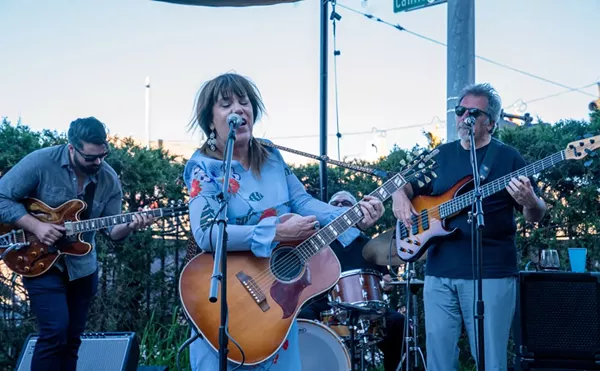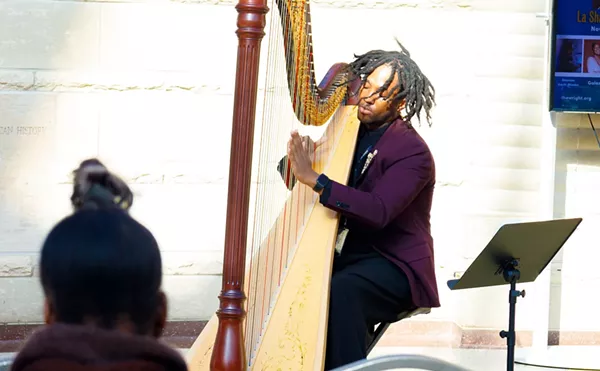
Audio By Carbonatix
[
{
"name": "GPT - Leaderboard - Inline - Content",
"component": "35519556",
"insertPoint": "5th",
"startingPoint": "3",
"requiredCountToDisplay": "3",
"maxInsertions": 100,
"adList": [
{
"adPreset": "LeaderboardInline"
}
]
}
]
In October 2007, I wrote a feature for Classic Rock magazine in the UK about Mitch Ryder & the Detroit Wheels, and what the members had done following the breakup of that band. Now that I live here in Detroit, I thought it would be cool to brush the thing off. Enjoy.
At one point in the mid 60’s, Mitch Ryder’s Detroit Wheels were one of the biggest selling acts in the States, and then they all but disappeared. Classic Rock journeyed to Detroit and delved into what became of one of America’s lost talents
Few could argue that the Detroit of the late sixties and early seventies was a musically vibrant city, with diversity in abundance. Motown was booming, and the likes of Bob Seger, Alice Cooper, The Stooges, MC5, Ten Nugent’s Amboy Dukes and Grand Funk Railroad were all receiving national acclaim, albeit in varying degrees. Riding high on the crest of this wave were Mitch Ryder’s Detroit Wheels. Ryder was born in 1945 in Hamtramck, a suburb of Detroit known for its high population of Polish immigrants, as William Levise Jr. At school he discovered a love for black rhythm and blues music and, keen to explore that side of his vocal range, he joined a band called Tempest. Soon after that, he joined the Peps, a quartet made up of mostly black singers, but his career was interrupted when he left Detroit for Los Angeles for a short time. On his return, he formed a band called Billy Lee and the Rivieras. The group comprised of bassist Earl Elliot, lead guitarist Jim McCarty, drummer Johnny ‘Bee’ Badanjek and rhythm guitarist Joe Kubert, who had played with Levise in Tempest. At the request of producer Bob Crewe, the group changed their name to the Detroit Wheels. Levise chose the name Mitch Ryder by randomly flicking through a phone directory, and he’s used it ever since. Ryder: “I cut a record on a gospel label in Detroit when I was 16 and I started frequenting a club called the Village downtown. Basically, it was black urban musicians that performed there and I was one of the few exceptions. I got involved singing with a black group there and I became a regular at the Village. Every once in a while they’d have auditions for new house bands coming through, I think essentially because the owners didn’t want to pay an established band. They would say that they were auditioning for a house band and the auditions you’d have to do for free. One weekend these three guys came through – Earl Elliot, Jimmy McCarty and Johnny Badanjek. Their mission was to back up all of the artists on the show, me being one of them. We did the performance and we talked – I was doing a solo thing then. We talked about getting together at some point in the future but we let it go. Then that Winter I went down with a good friend of mine from high school, Joe Kubert who later became rhythm player, and we were listening to the madness that surrounded the Beatles going on in America. We said to ourselves, ‘this is a piece of shit, we can do that’. We drove to Detroit and started to put a band together, and I remembered the guys that I’d met at The Village. We called them and arranged some rehearsal, pulled Joey in on rhythm and did some rehearsals together. That’s how it began.”
Johnny Bee: “The Beatles had just come out, and (Ryder) wanted to have a band like the Beatles. We said that we’d get together at my house and try it out, see what happens. Billy (Ryder) brought over a guitar player friend named Joe Kubert and that was the start of what was to become Mitch Ryder & the Detroit Wheels.”
From there, the band would rise rapidly, signing to the New Voice label. The Wheels would put five songs in the top forty between 1967 and 68, including classics like “Sock It To Me Baby” and “Devil With A Blue Dress On”. The band would record three albums in those years – 66’s Take A Ride, Breakout from the same year and 67’s Sock It To Me. While the first two would contain a lot of cover versions, the last album was made up almost entirely of original compositions and is widely considered their best record.
Johnny Bee: “We started playing all the T.V. shows. Dick Clark's American Bandstand, The Jerry Bevat Show - there were many more. And we started playing with all the big groups - The Dave Clark Five, Simon And Garfunkel, The Byrds, The Beach Boys (Brain Wilson thought Mitch was the greatest singer in America and said so in Rolling Stone Magazine), and many more. This stayed pretty even for about two years until Crewe decided that Mitch should become the white James Brown, than all bets were off and the train was about to come off the tracks.”
In 1967, disillusioned by the music business, Ryder broke up the Detroit Wheels in order to go solo. “There were differences between me and Jimmy, and we were both very strong personalities, so they alone couldn’t have broken the group up but I used to room with him and we’d argue constantly. We always came down to the fact that most of my heroes were black urban rhythm and blues artists and that was the direction I wanted to go in. Jimmy could play good rhythm and blues because he had grown up in Detroit, but he wanted to go more into a rock ‘n’ roll vein. I wanted to make the band bigger and he wanted to keep it small. That existed between us along with the agenda of the producer. There came a time and place where the producer made the split happen. We were miffed because we couldn’t do out own material, as we always had done. It was my goal to become a rhythm and blues singer at a time when the country was about to shit on rhythm and blues. They wouldn’t care about it anymore. Then there was flower power and the Brit invasion, which I adore.”
Before long though, Ryder and Johnny Bee were back together, this time simply called Detroit. Ryder: “There was a period of a couple of years where there was an attempt to reform the Detroit Wheels, which was ill-fated, and that morphed itself into the band Detroit. That was under the tutelage of Barry Kramer who published Creem magazine. Barry was my manager as well. Johnny (Bee) was in the Detroit band. That group was doomed for destruction. It was a bunch of some of the hardest living guys. The drug intake wasn’t even human. The level of anger and violence too – the beauty of it was that it was able to be channelled into the music. When you listen to the limited amount of music that was created by that group, you understand that the weird, powerful energy is coming from a place of anger and violence. Although it’s scary, it’s still incredible to listen to. I could handle one dose of that. I was only good for one album and then I walked away.”
Also in that band was bassist Ron Cooke. “I was running with that crowd of musicians anyway. The position became open and they were back in town. They called up and said, ‘hey, come on down and jam for a bit’. That’s when we were in the Creem Magazine building. I went down one afternoon in the summer, and it was hotter than Dickens up in there. We got to jamming and the next thing I know, they called and said ‘the car’s leaving town, be there’. We jumped in the limo and hit the road. One of the guitar players in that band was Mark Manko from the Catfish Blues Band with me too. We called Harry Phillips up, the keyboard cat. He played with the Catfish Blues Band, and he came out and we had the band together. It was a rolling circus after that. Johnny Bee had always been Mitch’s drummer. The Wheels had split up maybe 4 years before that, and I joined the Detroit band around 1969. I guess that Billy (Mitch) and Johnny were the driving force of putting that together. It was time for the Bee and Mitch to reunite.
The Detroit band was actually in a gunfight in a bar, two doors from Fenway Park in downtown Boston. That was one wild ass rock ‘n’ roll band right there, man. The guys that owned the bar pulled guns on us. We pissed them off, told ‘em to fuck off. Give us more whisky. It was over whisky and disrespect, and we told ‘em fuck you. We’re not kissing your ass, how do you like that? We were 22 and hard as fucking steel.”
The Detroit band was managed by one John Sinclair, who had previously made a name for himself as the manager of the MC5 and a political activist within his own party, the White Panthers. Ryder: “It’s something he tries to distance himself from because he’s trying to be a literary intellectual, but he can’t escape the fact that he did indeed manage Detroit. He was preoccupied with changing the world and the band, just like the MC5.”
Just like the Detroit Wheels though, Detroit would soon disintegrate under a great cloud of confusion and ultimately disappointment, following the release of just one self-titled album. Cooke: “We were gonna sign with Atlantic Records. We were on I think Paramount. I guess we had one of the biggest recording deals at that time – it was a huge amount of money. The band had incurred such debt from touring and different situations that when we got to the point where it was time to sign the contract, we couldn’t even pay off the debt with the contract. At that point in time, we would’ve been working for nothing. Everybody was so worn out. There was some talk of trying to go on (after Mitch left), but then we said ‘to hell with it’. Everybody just went their own way. It was 8 months to a year before anybody started working again. It was like being adrift in a sea of shit.”
Following the disintegration of the Detroit band, Mitch Ryder has been working under his own name. Johnny Bee played with artists as prestigious as the Rockets, Alice Cooper (on his Welcome To My Nightmare album) and is currently a member of Detroit heroes the Howling Diablos. Jim McCarty went on to work heavily with Cactus. Ron Cooke would later work with former MC5 man Fred Smith’s Sonic’s Rendezvous Band, and later still with Wayne Kramer (MC5) and New York Doll / Heartbreaker Johnny Thunders in Gang War. He recently got together with Johnny Bee to record a new Detroit band CD, although Ryder was notable by his absence. Cooke: “That was something we threw together in a couple of days. The winged logo was up for grabs, and I started a corporation that secured it, because that was the Detroit band’s logo. We called that band the Detroit II band, and we were using the logo with it. The singer is Tommy Ingham. He’s been singing around town for a long time. Guitarist Mike Katon, who’s on that CD with us, was calling around looking for a vocalist and somebody suggested Tommy. He came down and sang on a couple of tracks and it seemed to hit pretty good. We just kept rolling with it. We have another 12 tracks that aren’t mixed yet.”
The names Mitch Ryder, The Detroit Wheels and the Detroit band are permanently etched into rock ‘n’ roll history, and musicians of the quality of Johnny Bee, Jimmy McCarty and Ron Cooke will rarely be out of work. But when listening to Sock It To Me and Detroit, it’s impossible not to wonder what might have been if this group of extraordinary musicians had been better managed. It’s not uncommon in rock ‘n’ roll for this much promise to go up in smoke. But the quality of the music that this group of men made together is so incredible, the story of Mitch Ryder and The Detroit Wheels really must go down as one of rock’s great tragedies
Follow @City_Slang




